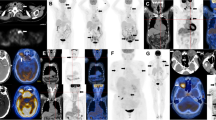Abstract
IgG4-related disease is a recently proposed clinical entity with several unique clinicopathological features. A chronic inflammatory state with marked fibrosis, which can often be mistaken for malignancy, especially by clinical imaging analyses, unifies these features. Little is known about lymphomagenesis in the context of IgG4-related disease, we recently first reported the ocular adnexal marginal zone B-cell lymphomas arising from IgG4-related disease. To the best of our knowledge, no existing study has ever established the neoplastic potential of IgG4-producing cells. In the present report, we describe the first IgG4-producing lymphoma. The patient was a 72-year-old male who was being followed for an asbestos-related pleural plaque. During follow-up, computed tomography revealed bilateral renal masses and multiple swollen retroperitoneal lymph nodes. A retroperitoneal lymph node biopsy was performed. Histologically, the interfollicular areas were expanded by medium to large plasmacytoid cells. These plasmacytoid cells showed nuclear pleomorphism and had prominent Russell bodies. Immunohistochemistry and double immunofluorescence staining of these cells revealed IgG4 positivity and monotypic lambda-light chain predominance. A portion of these cells were partially positive for CD20, negative for CD3, and somewhat faintly positive for CD138. In addition, serum IgG4 was elevated. Southern blot analysis of the lymph node specimen detected immunoglobulin heavy chain gene rearrangement. The present study indicates that, not only can malignant lymphomas occur in the setting of IgG4-related disease, but IgG4-producing cells can also be neoplastic.





Similar content being viewed by others
References
Kojima M, Miyawaki S, Takada S, et al. Lymphoplasmacytic infiltrate of regional lymph nodes in Küttner’s tumor (chronic sclerosing sialadenitis): a report of 3 cases. Int J Surg Pathol. 2008;16:263–8.
Hamano H, Kawa S, Horiuchi A, et al. High serum IgG4 concentrations in patients with sclerosing pancreatitis. N Engl J Med. 2001;344:732–8.
Kamisawa T, Nakajima H, Egawa N, et al. IgG4-related sclerosing disease incorporating sclerosing pancreatitis, cholangitis, sialadenitis and retroperitoneal fibrosis with lymphadenopathy. Pancreatology. 2006;6:132–7.
Kitagawa S, Zen Y, Harada K, et al. Abundant IgG4-positive plasma cell infiltration characterizes chronic sclerosing sialadenitis (Küttner’s tumor). Am J Surg Pathol. 2005;29:783–91.
Kojima M, Sipos B, Klapper W, et al. Autoimmune pancreatitis: frequency, IgG4 expression, and clonality of T and B cells. Am J Surg Pathol. 2007;31:521–8.
Sakata N, Tashiro T, Uesugi N, et al. IgG4-positive plasma cells in inflammatory abdominal aortic aneurysm: the possibility of an aortic manifestation of IgG4-related sclerosing disease. Am J Surg Pathol. 2008;32:553–9.
Sato Y, Ohshima K, Ichimura K, et al. Ocular adnexal IgG4-related disease has uniform clinicopathology. Pathol Int. 2008;58:465–70.
Yamamoto M, Takahashi H, Ohara M, et al. A new conceptualization for Mikulicz’s disease as an IgG4-related plasmacytic disease. Mod Rheumatol. 2006;16:335–40.
Ito T, Nakano I, Koyanagi S, et al. Autoimmune pancreatitis as a new clinical entity. Three cases of autoimmune pancreatitis with effective steroid therapy. Dig Dis Sci. 1997;42:1458–68.
Kamisawa T, Yoshiike M, Egawa N, et al. Treating patients with autoimmune pancreatitis: results from a long-term follow-up study. Pancreatology. 2005;5:234–8.
Ochoa ER, Harris NL, Pilch BZ. Marginal zone B-cell lymphoma of the salivary gland arising in chronic sclerosing sialadenitis (Küttner’s tumor). Am J Surg Pathol. 2001;25:1546–50.
Cossman J, Zehnbauer B, Garrett CT, et al. Gene rearrangements in the diagnosis of lymphoma/leukemia. Guidelines for use based on a multi-institutional study. Am J Clin Pathol. 1991;95:348–54.
Van der Zee JS, Aalberse RC. Immunochemical characteristics of IgG4 antibodies. N Engl Reg Allergy Proc. 1988;9:31–3.
Traverse-Glehen A, Felman P, Callet-Bauchu E, et al. A clinicopathological study of nodal marginal zone B-cell lymphoma. A report on 21 cases. Histopathology. 2006;48:162–73.
Harris NL, Jaffe ES, Stein H, et al. A revised European–American classification of lymphoid neoplasms: a proposal from the International Lymphoma Study Group. Blood. 1994;84:1361–92.
Kojima M, Inagaki H, Motoori T, et al. Clinical implications of nodal marginal zone B-cell lymphoma among Japanese: study of 65 cases. Cancer Sci. 2007;98:44–9.
Author information
Authors and Affiliations
Corresponding author
About this article
Cite this article
Sato, Y., Takata, K., Ichimura, K. et al. IgG4-producing marginal zone B-cell lymphoma. Int J Hematol 88, 428–433 (2008). https://doi.org/10.1007/s12185-008-0170-8
Received:
Revised:
Accepted:
Published:
Issue Date:
DOI: https://doi.org/10.1007/s12185-008-0170-8




